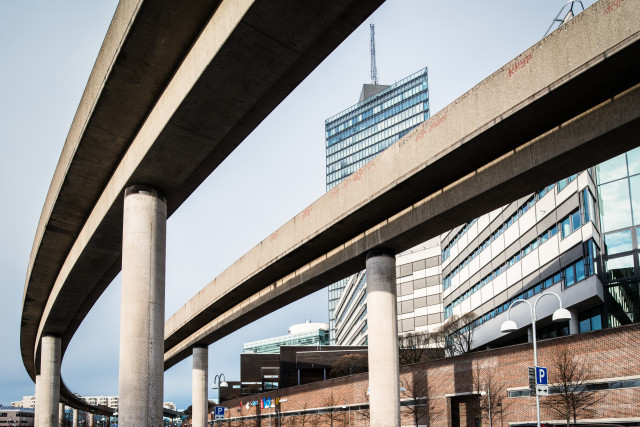Undervisningsspråk: Svenska
AH1031 Transport och samhälle 7,5 hp

Information per kursomgång
Information för HT 2025 Start 2025-08-25 programstuderande
- Studielokalisering
KTH Campus
- Varaktighet
- 2025-08-25 - 2025-10-24
- Perioder
HT 2025: P1 (7.5 hp)
- Studietakt
50%
- Anmälningskod
50709
- Undervisningsform
Normal Dagtid
- Undervisningsspråk
Svenska
- Kurs-PM
- Kurs-PM är inte publicerat
- Antal platser
Min: 13
- Målgrupp
- Ingen information tillagd
- Planerade schemamoduler
- [object Object]
- Schema
Kontakt
Kursplan som PDF
Notera: all information från kursplanen visas i tillgängligt format på denna sida.
Kursplan AH1031 (HT 2021–)Innehåll och lärandemål
Kursupplägg
Kursinnehåll
Utgångspunkten för ämnet transportplanering är att transporter styrs av människors resefterfrågan och dess behov att delta i aktiviteter. Vi färdas för att få tillgång till andra människor, varor samt möjligheter. Dessa observationerär viktigt ställningstagande för kursens fokus, nämligen att transport och samhälle är oskiljaktigt sammanlänkade där endera part påverkar varandra.
Det har tidigare funnits en tendens att betrakta transportsystemet som något vilket bara existerar för att möta våra behov. Denna kurs visar dock att transportsystemet snarare existerar för att stödja samhället, men även att förändringar i transportsystemet och dess användning formar samhället, och likaså att förändringar i samhället och vår livsstil påverkar transportsystemet.
Att placera transport i ett socialt sammanhang har blivit alltmer viktigt då en förändring inom betoningen i transportpolicy har skett, från att tillgodose efterfrågan av transporter till hanteringen av efterfrågan av transport. Att göra den senare introducerar ett ökat behov för att förstå komplexiteten samt förändringen i policyn för allmänhetens attityd samt transportbeteende. För att vidare utforska dessa ämnen är kursen utvecklad enligt följande;
1. Kursen inleder med att undersöka tillvägagångssättet för utvecklingen av transport och stadsplanering i Sverige samt skiftet från att förutsäga och tillhandahålla till mer omfattande hantering och planering. Vidare diskuteras sambandet mellan transport och samhällsplaneringsparadigmer som berör bredare sociala aspekter, samt ekonomiska indikatorer och demand management-koncept
2 Diskussionen fortsätter därefter med att undersöka hurförutsättningar i samhället varierar samt vilka behov, attityder och beteenden olika grupper av resenärer har. Detta leder till att studera hur olika fenomen inom samhället, såsombilberoendet, virtual mobility samt det relativa värdet av tid.
3. Kursens fokus rör sig därefter mot en mer abstrakt men subtil diskussion, nämligen tillgänglighet samt social exludering. Detta är ett komplext fenomen som omfattar vissa gruppers begränsade möjligheter att delta i samhället. Detta kan uppstå som en konsekvens av otillgänglighet i form av begränsad valfrihet av transportsätt, antingen genom fysisk tillgänglighet eller priskänslighet. Kursen undersöker även vad som menas med social exklusion och kopplingen mellan transport och social exkludering samt effekten på individens privat och arbetsliv och välbefinnande.
4. Efter de filosofiska diskussionerna diskuteras praktiska lösningar och policyalternativ. Vidare behandlas strategier som svenska myndigheter har framför att förändra transportbeteende genom bl.a mobility och parkerings-management, trafiksäkerhetsåtgärder samt lugna gator "road calming" och andra lokala samt regionala strategier.
5. Kursen avslutas därefter med utblicker mot framtiden utifrån olika stads- och transportscenarion, förväntningar samt långsiktiga mål.
Lärandemål
Efter avslutad kurs ska studenten kunna:
1. Identifiera koplingen mellan val av de olika färdmedel, transportbehov och tillgängighet;
2. Beskriva och analysera det komplexa samspelet mellan transport och olika kontexter i samhället;
3. Tillämpa dennes kunskap inom ämnet i nuvarande praxis inom transport, trafik- och stadsplanering; samt,
4. Visa förmåga att bilda och uttrycka konstruktiv kritik gentemot olika planeringspolicy som tar hänsyn för samhälleliga och beteende-dimensioner.
Kurslitteratur och förberedelser
Särskild behörighet
Aktivt deltagande i kursen AH1030 Stadsutveckling och transportsystem
Kurslitteratur
Examination och slutförande
Betygsskala
Examination
- PRO1 - Grupparbete, 3,5 hp, betygsskala: P, F
- TEN1 - Tentamen, 4,0 hp, betygsskala: A, B, C, D, E, FX, F
Examinator beslutar, baserat på rekommendation från KTH:s handläggare av stöd till studenter med funktionsnedsättning, om eventuell anpassad examination för studenter med dokumenterad, varaktig funktionsnedsättning.
Examinator får medge annan examinationsform vid omexamination av enstaka studenter.
När kurs inte längre ges har student möjlighet att examineras under ytterligare två läsår.
PRO1. Grupparbete 3,5 hp
TEN1. Tentamen 4,0 hp
Examinator
Etiskt förhållningssätt
- Vid grupparbete har alla i gruppen ansvar för gruppens arbete.
- Vid examination ska varje student ärligt redovisa hjälp som erhållits och källor som använts.
- Vid muntlig examination ska varje student kunna redogöra för hela uppgiften och hela lösningen.